In Washington’s rich tapestry of woodlands, ten distinct species of woodpeckers contribute to the ecological symphony, each playing a unique role in the state’s diverse ecosystems.
From the iconic Pileated Woodpecker with its resonant drumming to the elusive American Three-toed Woodpecker navigating coniferous forests, these birds are both a testament to nature’s biodiversity and essential contributors to forest health.
As we delve into the fascinating array of woodpecker species in Washington, we uncover the intricacies of their behaviors, habitats, and the challenges they face.
Join us on a journey through the evergreen landscapes where woodpeckers thrive and explore these avian inhabitants’ vital role in maintaining the delicate balance of Washington’s natural world. Stay sharp.
10 Woodpeckers in Washington
In the diverse woodlands of Washington, a symphony of woodpecker species contributes to the rich tapestry of local ecosystems.
From the iconic Pileated Woodpecker to the elusive Williamson’s Sapsucker, each bird plays a unique role in maintaining the balance of nature. Explore the fascinating lives of these woodpeckers in the Evergreen State.
1. Pileated Woodpecker
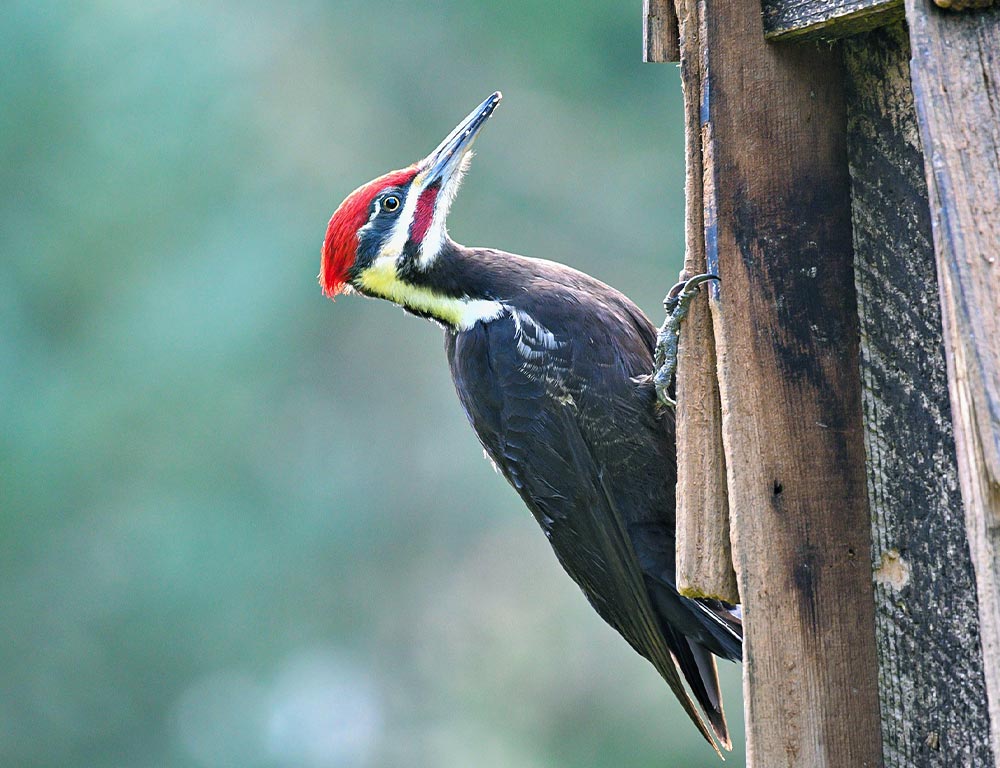
- Scientific Name: Dryocopus pileatus
- Category: Woodpecker
- Population: Stable
- Life Span: 4-12 years
- Size: 16-19 inches
- Weight: 8-12 ounces
- Food: Insects, especially carpenter ants and wood-boring beetle larvae, fruits, and nuts
- Wingspan: 26-30 inches
- Status: Least Concern
With its striking red crest and large size, the Pileated Woodpecker is an iconic woodpecker species in Washington. These birds are often found in mature forests with plenty of dead or decaying trees, as they prefer to excavate large cavities in dead wood for nesting.
Their strong beaks and long, barbed tongues are well-suited for extracting insects from tree bark, particularly carpenter ants and wood-boring beetle larvae. They also feed on fruits and nuts, showcasing a diverse diet.
Pileated Woodpeckers have a distinctive drumming sound, which is a rapid and resonant drum roll created by hammering on trees. Their expansive wingspan and powerful flight make them impressive to observe in their natural habitat.
Although they face habitat loss due to deforestation, their population remains stable and is classified as Least Concern. Their adaptability to various wooded environments contributes to their resilience.
Regarding behavior, Pileated Woodpeckers are often solitary birds, and their territorial drumming is a means of communication between individuals. They play a vital role in forest ecosystems by controlling insect populations and creating nesting sites for other cavity-nesting species.
2. Downy Woodpecker
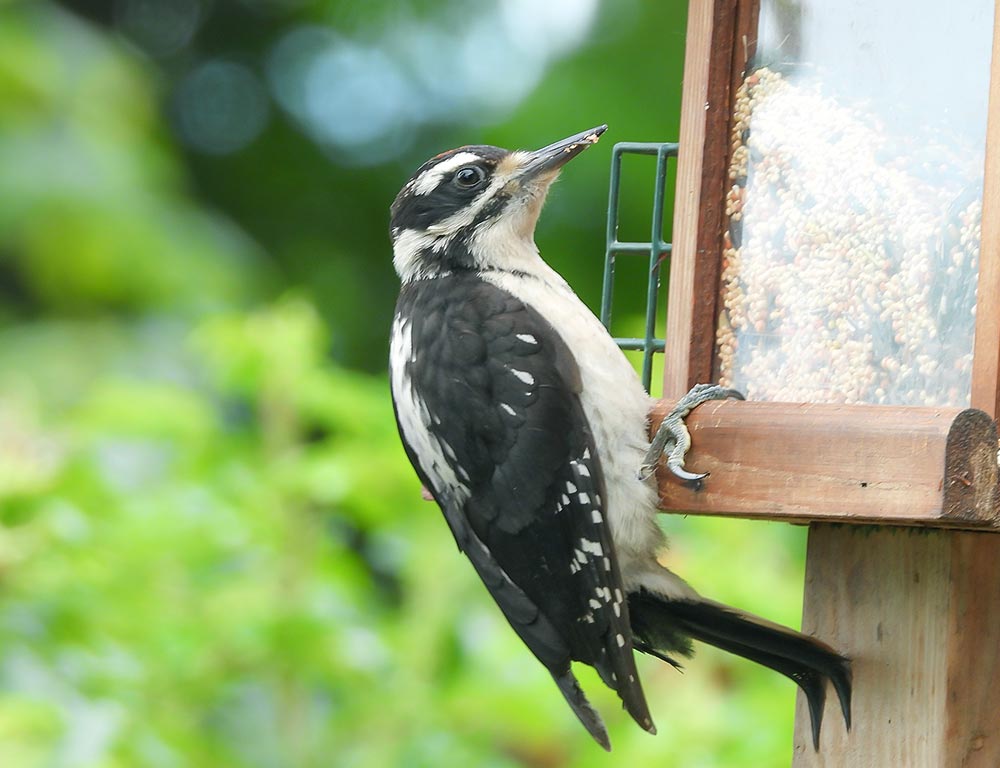
- Scientific Name: Dryobates pubescens
- Category: Woodpecker
- Population: Abundant
- Life Span: 4-6 years
- Size: 6-7 inches
- Weight: 0.7-1 ounce
- Food: Insects, seeds, berries
- Wingspan: 9-12 inches
- Status: Least Concern
The Downy Woodpecker, the smallest woodpecker species in North America, is a common sight in Washington’s woodlands. It can be easily identified with its distinctive black and white plumage and a small, chisel-like bill.
These birds are highly adaptable and are found in various wooded habitats, including parks, gardens, and suburban areas.
Downy Woodpeckers primarily feed on insects, including beetles, ants, and caterpillars, but they also consume seeds and berries. Their foraging behavior involves tapping on tree trunks and branches to locate hidden insects and extract them with their specialized tongues.
Despite their diminutive size, they play a crucial role in controlling insect populations and aiding in the overall health of forests. Known for their drumming, Downy Woodpeckers use rhythmic patterns to communicate with each other and establish territory.
They are cavity nesters, creating nests in dead or decaying trees, and their nests are often reused by other species in subsequent years. Due to their adaptability and abundant population, Downy Woodpeckers are classified as Least Concern.
3. Lewis’s Woodpecker
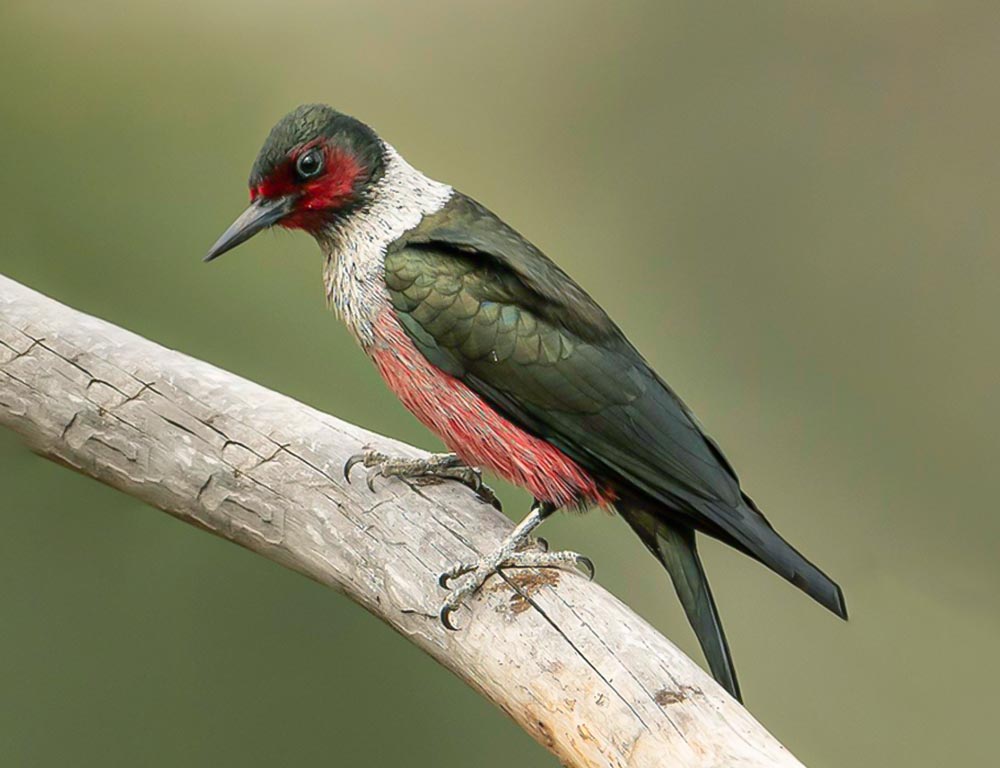
- Scientific Name: Melanerpes lewis
- Category: Woodpecker
- Population: Declining
- Life Span: 6-8 years
- Size: 10-11 inches
- Weight: 3-5 ounces
- Food: Insects, especially flying insects, berries, and occasionally seeds
- Wingspan: 18-20 inches
- Status: Near Threatened
Lewis’s Woodpecker is a unique and striking woodpecker species known for its dark plumage and pinkish-red belly.
Unlike typical woodpeckers, Lewis’s Woodpeckers have a distinctive foraging style that involves catching insects on the wing. They are often observed perched on exposed branches or dead trees, sallying out to catch flying insects, such as beetles, wasps, and ants.
This woodpecker species also consumes berries and occasionally seeds, displaying a more diverse diet than other woodpeckers. Their foraging behavior and dietary preferences make them well-adapted to open woodlands, burned areas, and savannas.
Lewis’s Woodpecker populations are declining, primarily due to habitat loss and alteration and changes in forest management practices. Conservation efforts are critical to address these threats and preserve their unique habitats.
These woodpeckers are cavity-nesters and often use old woodpecker holes or natural tree cavities for nesting. The Near Threatened status emphasizes the urgency of conservation actions to protect their habitats and address the factors contributing to their population decline.
4. Northern Flicker
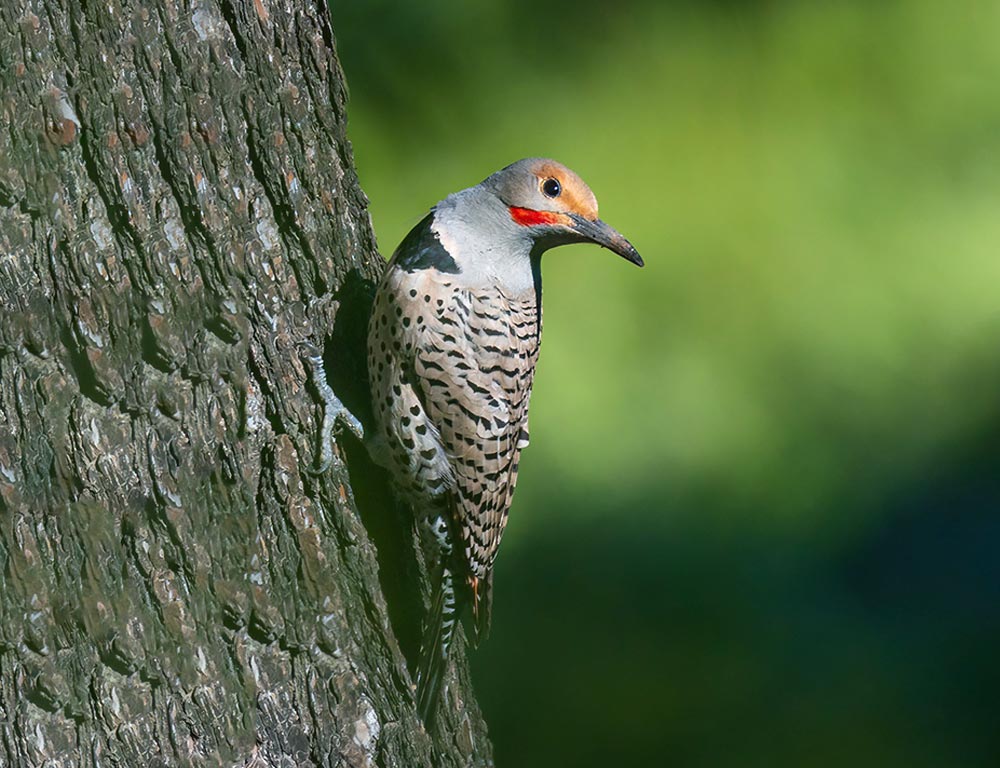
- Scientific Name: Colaptes auratus
- Category: Woodpecker
- Population: Stable
- Life Span: 6-7 years
- Size: 11-14 inches
- Weight: 3-5 ounces
- Food: Insects, especially ants, beetles, fruits, and seeds
- Wingspan: 16-20 inches
- Status: Least Concern
The Northern Flicker is a medium to large woodpecker known for its distinctive appearance, with a barred black and brown back, a spotted breast, and a red crescent on the nape.
This woodpecker species is unique in its feeding habits, as it spends significant time foraging on the ground for ants and beetles. Their diet also includes fruits and seeds, making them more adaptable to various habitats.
Northern Flickers are commonly found in various environments, including open woodlands, urban areas, and grasslands. They are cavity-nesters, and unlike other woodpeckers, they often excavate holes in dead trees or use existing cavities for nesting.
Known for their drumming, Northern Flickers produce a rhythmic sound during the breeding season to communicate with potential mates and establish territory.
Their populations are stable, and they are classified as Least Concern. They are crucial in insect control and contribute to seed dispersal in their ecosystems.
Conservation efforts for Northern Flickers focus on preserving mature trees for nesting sites and maintaining a diverse landscape that provides suitable foraging opportunities.
5. Black-backed Woodpecker
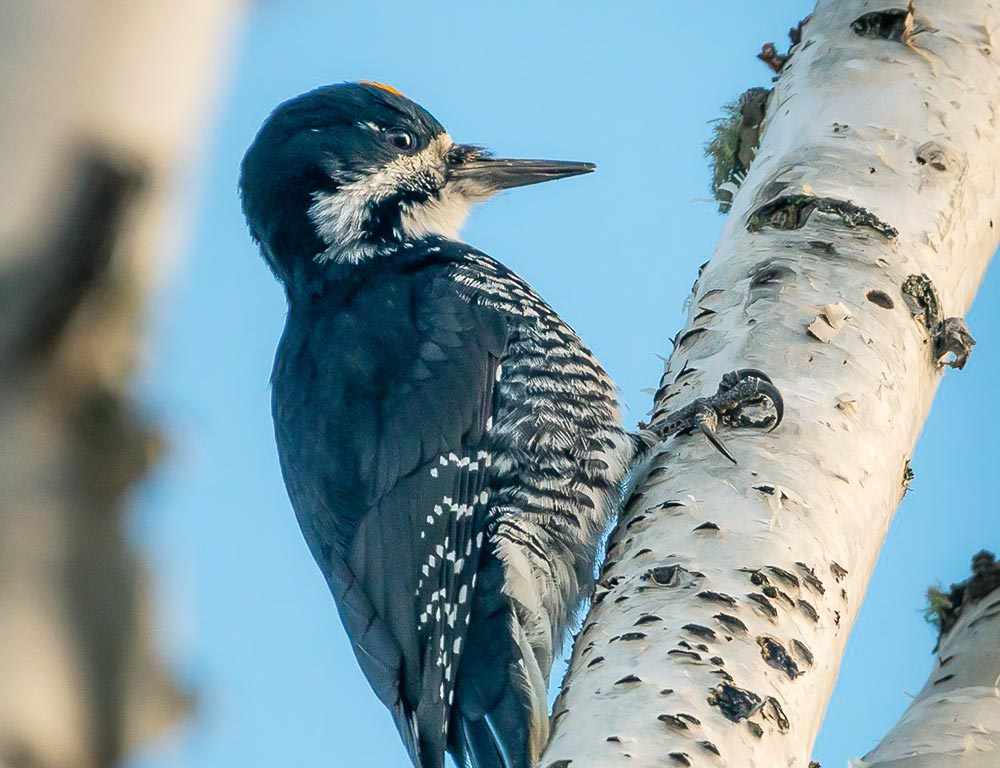
- Scientific Name: Picoides arcticus
- Category: Woodpecker
- Population: Stable
- Life Span: 5-8 years
- Size: 9-10 inches
- Weight: 2-3 ounces
- Food: Insects, especially wood-boring beetles and their larvae
- Wingspan: 16-18 inches
- Status: Least Concern
The Black-backed Woodpecker is a striking bird known for its black plumage and distinct white markings. Found in coniferous forests, especially those recently affected by fire or insect outbreaks, they have adapted to exploit the abundance of dead and decaying trees.
Their primary food source is wood-boring beetles and their larvae, which they extract with their strong bills. These woodpeckers play a vital role in ecosystem dynamics, helping to control bark beetle populations and contributing to forest regeneration.
They are well-suited to their specialized habitat, with adaptations that include a black back that provides camouflage against charred trees. Black-backed Woodpeckers are known for their persistence and ability to locate hidden insect larvae beneath the bark.
They create cavities for nesting in dead trees, and their presence is often associated with post-fire landscapes, making them an important component of the natural recovery process.
Despite facing some habitat challenges due to logging and changes in forest management practices, the Black-backed Woodpecker population remains stable, earning them a classification of Least Concern.
6. White-headed Woodpecker
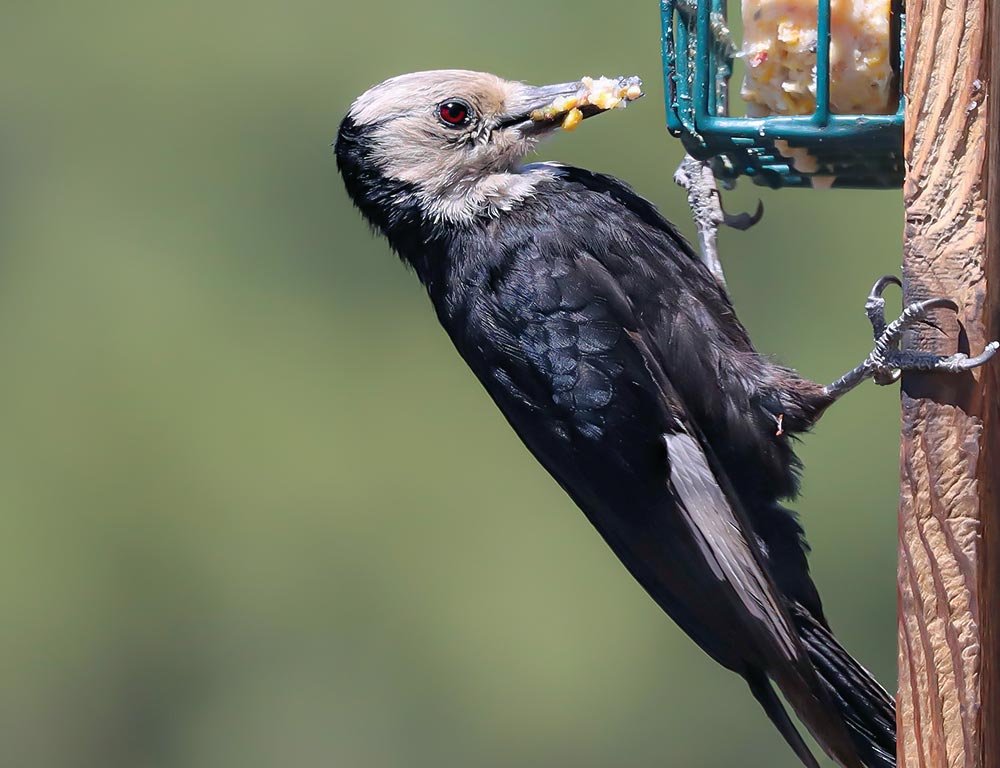
- Scientific Name: Dryobates albolarvatus
- Category: Woodpecker
- Population: Declining
- Life Span: 5-10 years
- Size: 8-9 inches
- Weight: 2-3 ounces
- Food: Insects, especially wood-boring beetles, seeds, and berries
- Wingspan: 15-17 inches
- Status: Near Threatened
The White-headed Woodpecker is a distinctive bird with a striking white head and black body. These woodpeckers inhabit coniferous forests, particularly in the western parts of North America.
They are highly specialized in their foraging habits, primarily feeding on wood-boring beetles and their larvae found beneath the bark of dead or dying trees.
White-headed Woodpeckers play a significant role in forest ecosystems by helping control insect populations and contributing to overall forest health.
Unfortunately, their population has been experiencing a decline, leading to their classification as Near Threatened. This decline is attributed to habitat loss, altered fire regimes, and competition for nesting sites with other woodpecker species.
In addition to insects, White-headed Woodpeckers also consume seeds and berries, displaying a more varied diet than some other woodpecker species. Their foraging behavior involves tapping on trees and probing the bark with their bills to extract hidden insects.
Conservation efforts are underway to address the factors contributing to their decline, emphasizing the importance of maintaining suitable habitat and forest management practices that support their unique ecological niche.
7. Red-breasted Sapsucker
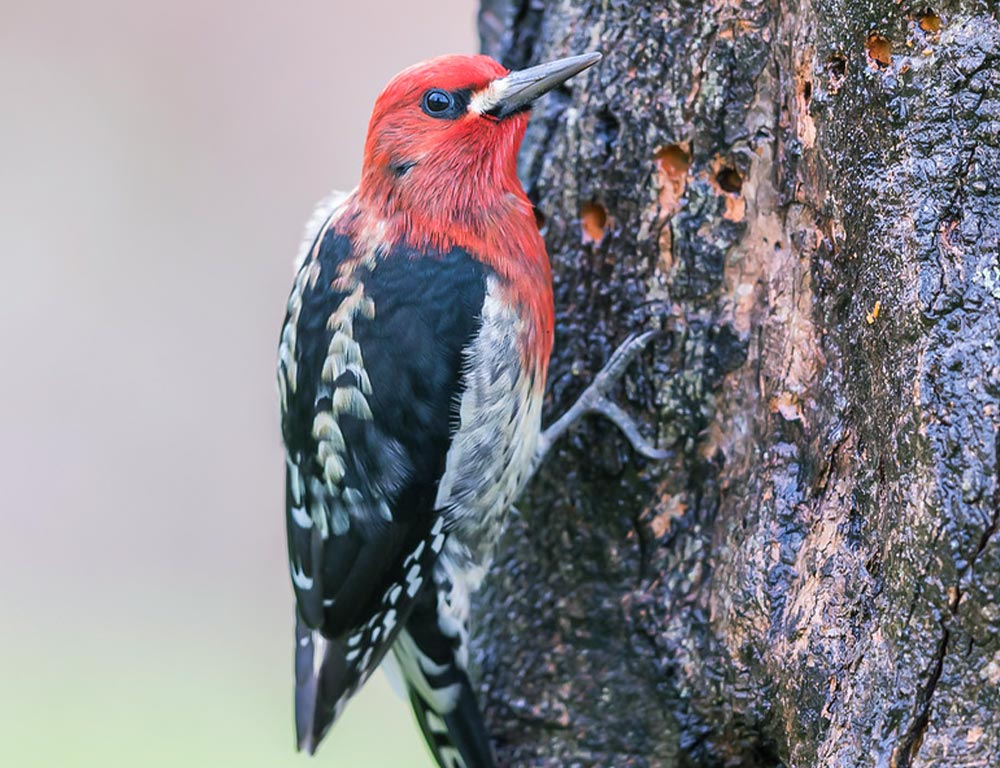
- Scientific Name: Sphyrapicus ruber
- Category: Woodpecker
- Population: Stable
- Life Span: 4-8 years
- Size: 8-10 inches
- Weight: 2-3 ounces
- Food: Sap, insects, tree sap, and cambium
- Wingspan: 13-16 inches
- Status: Least Concern
The Red-breasted Sapsucker is a distinctive woodpecker species with a striking red head and breast. These birds are known for their unique feeding behavior, as they drill rows of small holes into the bark of trees to feed on sap and the insects attracted to them.
They primarily inhabit coniferous and mixed forests, creating sap wells in various tree species. In addition to sap, Red-breasted Sapsuckers also consume insects and tree cambium, showcasing a diverse diet.
Their specialized tongues are adapted for extracting sap, and they play a role in shaping the structure of the forest by creating distinctive patterns of sap wells on tree trunks.
These woodpeckers are often found in mountainous regions and are known for their migratory behavior, with some individuals moving to lower elevations during the winter months.
Despite some challenges related to habitat loss, the Red-breasted Sapsucker population remains stable, earning them a classification of Least Concern.
Their ecological role in facilitating sap flow and creating habitat for other organisms highlights the interconnectedness of these woodpeckers with their forest environments.
8. Red-naped Sapsucker
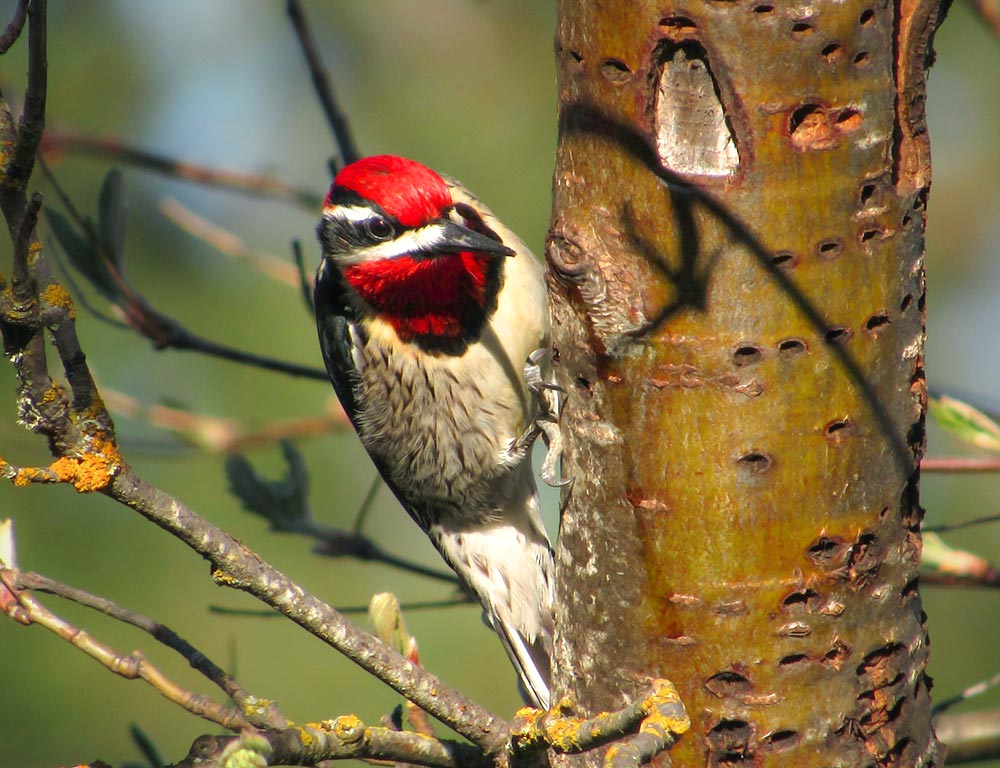
- Scientific Name: Sphyrapicus nuchalis
- Category: Woodpecker
- Population: Stable
- Life Span: 4-8 years
- Size: 8-9 inches
- Weight: 1.5-2 ounces
- Food: Sap, insects, tree sap, and cambium
- Wingspan: 13-16 inches
- Status: Least Concern
The Red-naped Sapsucker is a medium-sized woodpecker with distinctive black and white markings and a red patch on the nape of its neck.
Like other sapsuckers, they are known for their unique feeding behavior, drilling holes into the bark of trees to feed on sap, insects, and tree cambium.
Found in various forested habitats, including coniferous and mixed woodlands, they play a vital role in shaping the ecology of their environment.
Red-naped Sapsuckers are particularly associated with aspen and birch trees, where they create sap wells in specific patterns.
These sap wells provide a food source for the sapsuckers and attract other bird species, insects, and mammals. Their migratory behavior is influenced by changes in food availability, and they may move to lower elevations during the winter months.
Regarding conservation status, the Red-naped Sapsucker is classified as Least Concern, indicating a stable population. Conservation efforts focus on maintaining suitable habitats, as these woodpeckers depend highly on healthy, diverse forests.
9. Williamson’s Sapsucker
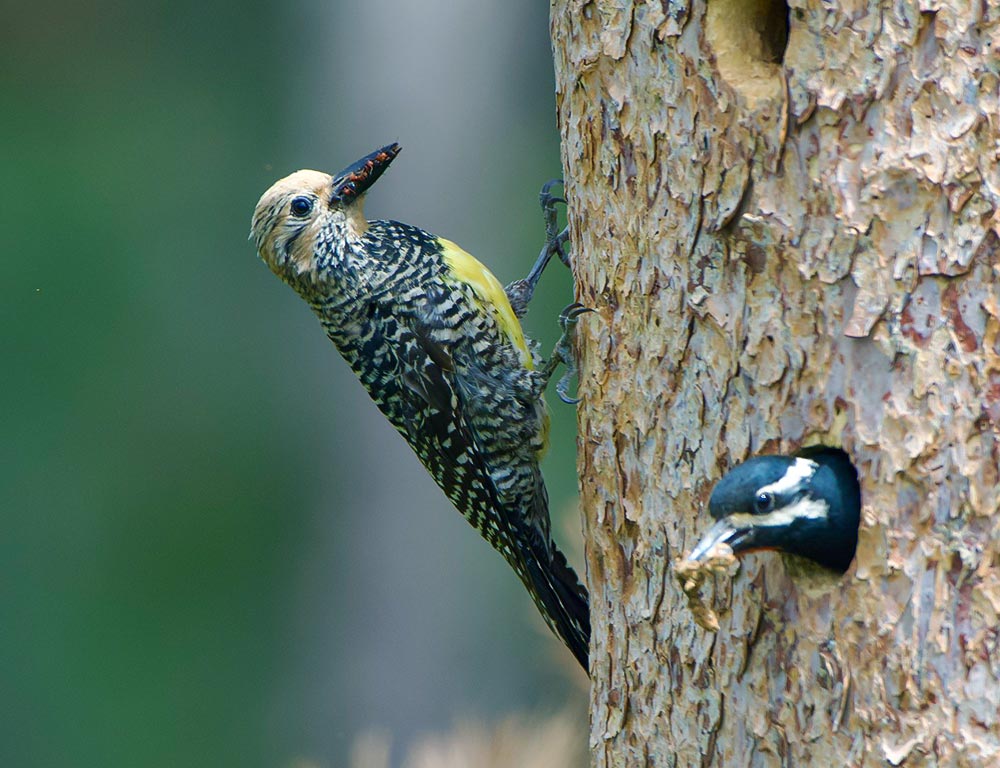
- Scientific Name: Sphyrapicus thyroideus
- Category: Woodpecker
- Population: Declining
- Life Span: 4-8 years
- Size: 8-10 inches
- Weight: 2-3 ounces
- Food: Sap, insects, and tree cambium
- Wingspan: 15-17 inches
- Status: Near Threatened
Williamson’s Sapsucker is a striking woodpecker species characterized by its black and white plumage, with males displaying a vibrant red throat and crown.
This species is associated with coniferous forests, particularly those containing mature pine trees. Like other sapsuckers, they feed on sap, insects, and tree cambium, creating distinctive sap wells on the trunks of their preferred trees.
The population of Williamson’s Sapsucker is declining, leading to their classification as Near Threatened. The main threats include habitat loss, logging activities, and changes in forest management practices.
Conservation efforts are crucial to address these issues and ensure the preservation of suitable habitats. Williamson’s Sapsuckers are known for their unique foraging behavior, focusing on specific pine tree types.
They create sap wells in a systematic manner, and these wells are not only a food source but also attract a variety of other wildlife, contributing to the overall biodiversity of their habitat.
To conserve Williamson’s Sapsucker populations, it is essential to implement habitat protection measures and promote sustainable forestry practices that support the ecological needs of this specialized woodpecker species.
10. American Three-toed Woodpecker
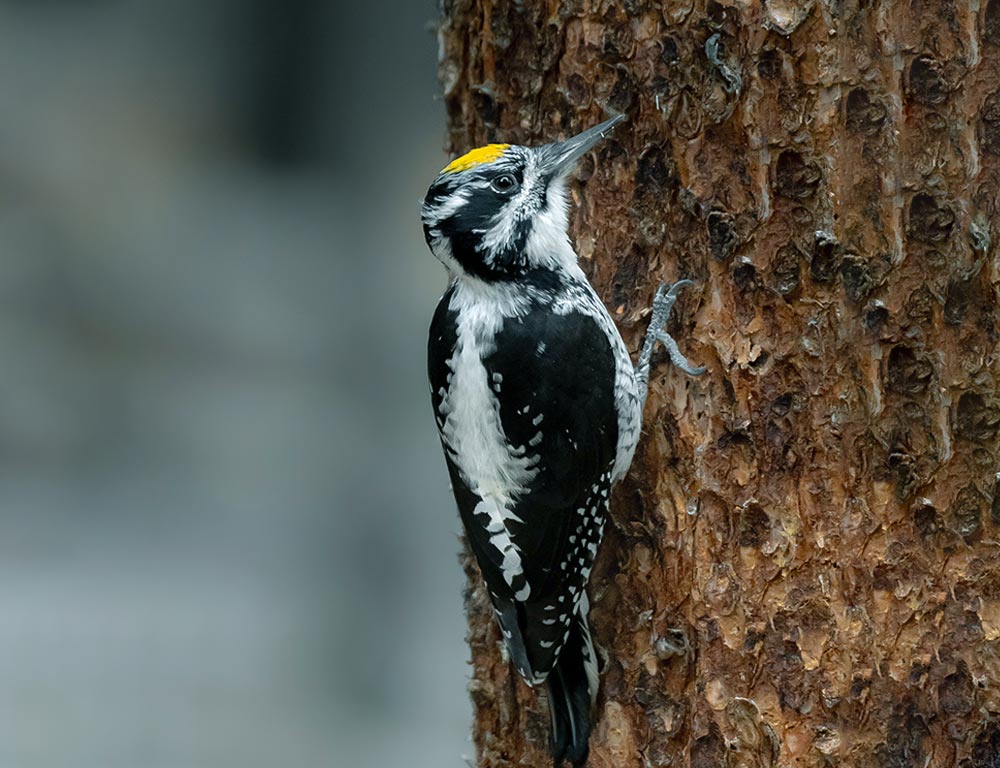
- Scientific Name: Picoides dorsalis
- Category: Woodpecker
- Population: Stable
- Life Span: 3-7 years
- Size: 8-9 inches
- Weight: 2-3 ounces
- Food: Insects, especially wood-boring beetles and their larvae
- Wingspan: 15-16 inches
- Status: Least Concern
The American Three-toed Woodpecker is a medium-sized woodpecker with a distinctive black-and-white coloration and, as the name suggests, only three toes on each foot.
Found in coniferous forests, especially those affected by disturbances like wildfires or insect outbreaks, they have adapted to exploit the abundance of dead and decaying trees.
This woodpecker species primarily feeds on insects, with a particular focus on wood-boring beetles and their larvae. Their foraging behavior involves scaling the bark in search of hidden prey, and their unique foot structure aids in maneuvering on the trunks of trees.
American Three-toed Woodpeckers play an essential role in forest ecosystems by helping control bark beetle populations and contributing to the overall health of the forest.
Despite facing some habitat challenges due to logging and changes in forest management practices, their population remains stable, earning them a classification of Least Concern.
Conservation efforts focus on maintaining suitable habitat conditions, including preserving areas with standing dead trees, which are crucial for their foraging and nesting activities.
How to Increase the Number of Woodpeckers in Washington?
Washington’s woodpeckers, vital to forest ecosystems, face challenges due to habitat loss and changing environmental conditions. Increasing their numbers requires thoughtful conservation efforts.
Here are some of the key strategies to enhance and sustain woodpecker populations in the Evergreen State.
Preserve and Restore Habitat
Protecting and restoring diverse forest habitats, especially mature trees and deadwood areas, provides essential environments for woodpeckers to nest, forage, and thrive.
Sustainable Logging Practices
Implementing sustainable forestry practices that maintain suitable habitats, including leaving dead trees, supports woodpeckers by balancing human activities and ecological needs.
Address Climate Change Impacts
Mitigating the effects of climate change, such as wildfires and temperature shifts, is crucial. These changes impact woodpecker habitats, and proactive measures can help safeguard their ecosystems.
Educate the Public
Raise awareness about the importance of woodpeckers in maintaining healthy forests. Public education fosters support for conservation initiatives and encourages responsible outdoor practices.
Create Nesting Opportunities
Installing artificial nest boxes mimicking natural cavities can provide additional nesting opportunities, especially in areas with limited deadwood, supporting woodpecker breeding efforts.
Monitor and Research
Continuously monitor woodpecker populations, study their behaviors, and assess the impact of conservation efforts. Research-driven initiatives provide valuable insights for adaptive management strategies.
By adopting these comprehensive measures, Washington can pave the way for a more resilient and flourishing woodpecker population, benefiting both the birds and the broader ecosystem.
Wrapping Up
A harmonious balance between conservation efforts and human activities is paramount in safeguarding Washington’s woodpeckers.
As stewards of the state’s diverse ecosystems, adopting sustainable practices, restoring habitats, and promoting awareness ensures the preservation of these vital avian contributors.
By prioritizing the needs of woodpeckers, we secure the health of our forests and uphold the intricate ecological web they weave. Thank you so much.